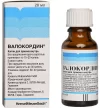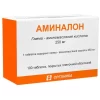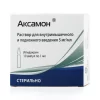Description
Mexiprim Pharmacodynamics
Mexiprim is a derivative of 3-oxypyridine, and has antioxidant, antihypoxic, anti-ischemic, membrane-protective, nootropic, stress-protective, anticonvulsant, anxiolytic, hypolipidemic action.
The mechanism of action of the drug is due to the antioxidant, antihypoxant and membranoprotective effects. Mexiprim reduces manifestations of oxidative stress, inhibits lipid peroxidation, increases superoxide dismutase activity, increases lipid-protein ratio, improves cell membrane structure and function. The drug modulates the activity of membrane-bound enzymes (calcium-independent phosphodiesterase, adenylate cyclase,
acetylcholinesterase), receptor complexes (benzodiazepine, gamma-aminobutyric acid (GABA), acetylcholine), which increases their ability to bind to ligands, contributes to preservation of structural and functional organization of biomembranes, transport of neurotransmitters and improves synaptic transmission. Mexiprim increases the content of dopamine in the brain. It causes enhancement of compensatory activation of aerobic glycolysis and reduction of the degree of inhibition of oxidative processes in the Krebs cycle under hypoxia with an increase in adenosine triphosphate (ATP) and creatine phosphate, activation of energy-synthesizing functions of mitochondria, stabilization of cell membranes.
The drug has a wide range of pharmacological activity; it increases resistance of the organism to stress and various damaging factors under pathological conditions (hypoxia and ischemia, impaired cerebral circulation, intoxication with ethanol and antipsychotic drugs).
Under conditions of critical reduction of coronary blood flow, it promotes preservation of structural and functional organization of cardiomyocyte membranes, stimulates the activity of membrane enzymes (phosphodiesterase, adenylate cyclase, acetylcholinesterase). It supports activation of aerobic glycolysis developing in acute ischemia and promotes under hypoxia restoration of mitochondrial redox processes, increases synthesis of ATP and creatine phosphate. Ensures the integrity of morphological structures and physiological functions of ischemic myocardium. Improves the clinical course of myocardial infarction, increases the effectiveness of therapy, reduces the incidence of arrhythmias and intracardiac conduction abnormalities. Normalizes metabolic processes in ischemic myocardium, increases the antianginal activity of nitrates, improves blood rheological properties, reduces the consequences of reperfusion syndrome in acute coronary failure.
It improves functional state of ischemic myocardium. In coronary insufficiency increases collateral blood supply of ischemic myocardium, contributes to preservation of cardiomyocyte integrity and maintenance of their functional activity. Effectively restores myocardial contractility in reversible cardiac dysfunction.
It improves brain tissue metabolism and blood supply, improves microcirculation and rheological properties of blood, reduces platelet aggregation. Stabilizes membrane structures of blood cells (red blood cells and platelets). It has a hypolipidemic effect, reduces the content of total cholesterol and low-density lipoproteins.
It shows an anxiolytic effect, which is not accompanied by muscle relaxant effect; it has nootropic properties, prevents and reduces learning and memory disorders that occur with aging and exposure to various pathogenic factors; it has anticonvulsant effect; increases attention concentration and performance.
Anti-stressor effect is manifested in the normalization of post-stress behavior, somatovegetative disorders, restoration of sleep-wake cycles, disturbed learning and memory processes, reducing dystrophic and morphological changes in various structures of the brain.
It reduces enzymatic toxemia and endogenous intoxication in acute pancreatitis.
It has a pronounced antitoxic effect during withdrawal syndrome. It eliminates neurological and neurotoxic symptoms of acute alcohol intoxication, restores behavioral disorders, autonomic functions, helps to reduce the severity of cognitive disorders caused by prolonged ethanol intake. Under the influence of the drug the effect of tranquilizing, neuroleptic, antidepressant, sleeping pills and anticonvulsants increases, which allows reducing their doses and side effects.
Indications
– Consequences of acute violations of cerebral circulation, including after transient ischemic attacks, in the phase of subcompensation as a preventive course;
– Mild craniocerebral trauma, the consequences of craniocerebral injuries;
– Encephalopathies of different genesis (dyscirculatory, dysmetabolic, post-traumatic, mixed);
– Autonomic dystonia syndrome;
– Mild cognitive disorders of atherosclerotic genesis;
– Anxiety disorders in neurotic and neurosis-like conditions;
– Coronary heart disease as part of complex therapy;
– Treatment of withdrawal syndrome in alcoholism with a predominance of neurotic and vegetative vascular disorders, postabstinence disorders;
– States after acute intoxication with antipsychotic drugs;
– Asthenic conditions, as well as for the prevention of the development of somatic diseases under the influence of extreme factors and stress;
– The impact of extreme (stressor) factors.
Contraindications
Acute liver and kidney function abnormalities, hypersensitivity to the active substance and other components of the drug. Because of the insufficient study of the drug – childhood, pregnancy, breast-feeding.
Dosage and administration method.
- Inside. By 125-250 mg (1-2 tablets) 3 times a day.
- The initial dose is 125-250 mg (1-2 tablets) 1 to 2 times a day with a gradual increase until the therapeutic effect is achieved. Maximal daily dose is 750 mg (6 tablets).
- Duration of treatment – 2-6 weeks; for stopping alcohol withdrawal – 5-7 days. The duration of the course of therapy in patients with coronary heart disease is at least 1.5 to 2 months. Treatment is discontinued gradually, reducing the dose over 2-3 days.
- Repeated courses (as recommended by the doctor), it is desirable to conduct in the spring and autumn periods.





![Ethylmethylhydroxypyridine succinate (Mexiprim) 125 mg - [30 tablets]](https://mediscom.com.co/wp-content/uploads/2022/11/Mexiprim-125mg-30.webp)



